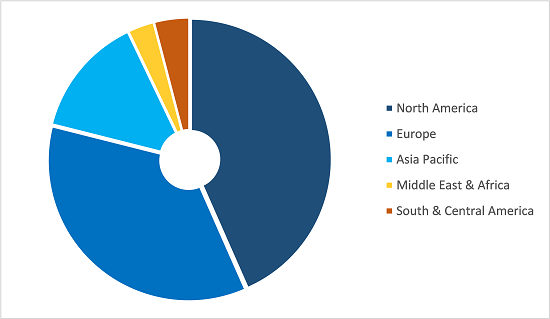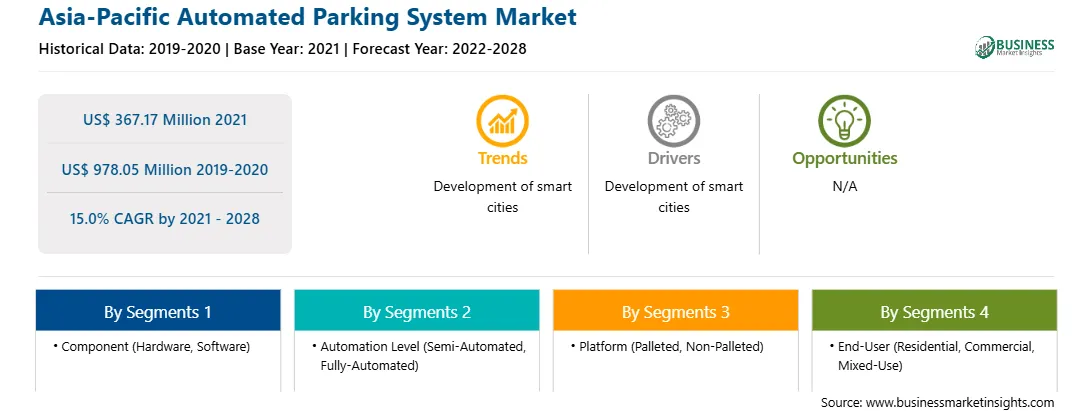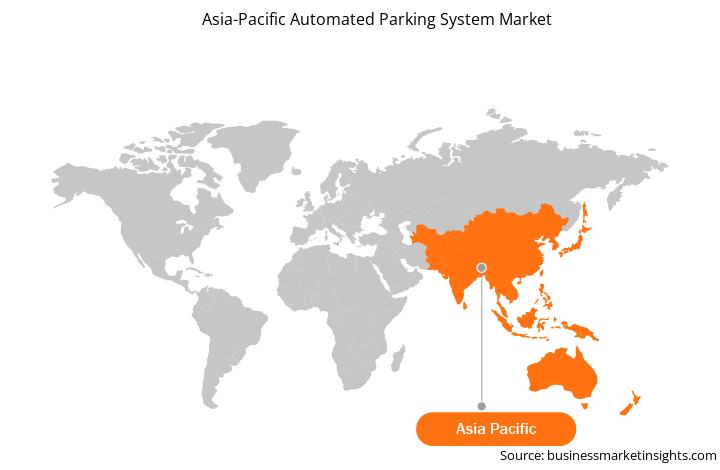Market Introduction
The automated parking system market in APAC is further segmented into China, India, Japan, Australia, and South Korea. The automated parking systems use AI and robotics to provide a smarter, more advanced car parking experience. This ensures next-level convenience for drivers as their vehicles can be automatically parked within a few minutes without the need to look for a parking place. The cutting-edge facility allows drivers to simply place their vehicles on the pallet inside the allocated chamber and then confirm at the kiosk to begin the parking procedure using a one-time passcode provided. The pallet and the car will be transported to a vacant parking space by an automated guided vehicle (AGV). To retrieve the vehicle, drivers simply needs to enter the allotted password into the kiosk, and the vehicle will be moved by the AGV to the specified chamber for pickup. Drivers can also use the robotic parking system apps to schedule car retrieval, view parking availability, and track the vehicle status. Hong Kong Science and Technology Parks Corporation (HKSTP) has introduced the city's first automatic robotic parking system with EV charging facility at Hong Kong Science Park, the city's largest R&D site. The robotic parking system, which will be located in Buildings 17W and 19W, will highlight Hong Kong's cutting-edge smart city innovation, and strengthen the city's vision for smarter living and smarter transportation. The new facility saves space by allowing ideal parking in numerous rows and columns (double-parking), and the process is assisted by AGVs that approach the parking pallets from multiple angles using omnidirectional motions. The AGVs, which are outfitted with precision laser navigation systems, can operate with high positional accuracy of ±5 mm. The AGVs, which are powered by innovative route planning algorithms, optimize space usage while also transporting each car along the most efficient route. As the unmanned parking facility requires minimum lighting and ventilation, it enables energy savings of up to 30%. Sensors and automation produce a zero-human operation that reduces the risk of accidents and crimes and enhances security and safety of users and vehicles. In a parking chamber, motion sensors are attached to ensure that no humans or dogs are left inside before parking automatically. AGVs are equipped with non-contact collision avoidance sensors, which cause them to come to a complete stop if an obstruction is detected. MHE-Demag Singapore presented Kim Eng Properties Pte Ltd a right solution for building parking at their redevelopment at 48 North Canal Road. As the new commercial building required eight parking lots and a traditional subterranean parking would not be economically feasible due to the size of the land, the company chose MHE-Demag's automated vehicle parking system to maximize its land area. MHE-Demag supplied and built a speedy automated parking system—Elevator Tower Parking (DET)—based on the site specifications, which included one car elevator, eight fixed-height vehicle parking platforms, and one slide-up auto door for security. The parking system is suitable for medium- to large-scale construction projects and can accommodate vehicles weighing up to 2,250 kg and measuring 2.15 m × 2 m × 5.25 m (W × H × L). The system is meant to transport and park vehicles quickly across many levels of a building's parking zone and to retrieve them in less than 3 minutes. Many safety measures, supported by sensors, were integrated into the parking system that protects users and automobiles; sensors ensure cars are properly positioned on the pallets and elevator, as well as identify the presence of vehicles and their height clearance. Furthermore, the system was developed for fast speed, low noise, and low vibration to comply with the severe standards of local authorities ensuring low disturbance to surrounding residents. Furthermore, the growing number of smart cities and technical improvements in autonomous vehicles are expected to provide significant growth opportunities for the companies operating in the automated parking system market in APAC.
The COVID-19 pandemic has not only disrupted the overall economy and automobile market in Asia-Pacific but has also changed the buyers' attitude toward the sector. A rise in consumer demand for expensive safety features is encouraging manufacturers to invest in high-end technology solutions and services into their products. The car industry was the first economic victim of COVID-19 in China with the shutdown of major automotive production sites and manufacturing plants of companies such as GM, Honda, Nissan, and Renault in the Hubei Province. Other countries in Asia-Pacific recorded dramatic double-digit drops in vehicle sales due to their dependency on the automotive and automotive component market in China and interruptions caused by the pandemic. There is a growing trend of online buying and picking the goods bought online from the actual stores in proximity, which may bolster the demand for convenient parking to facilitate order pickups. Demand for technologies that reduce contact between people and surfaces, such as payment systems, elevator buttons, and door handles, would further rise amid the COVID-19 pandemic. Difficulties in gathering necessary funding would further impact the market growth. Key players in the automated parking system market in Asia-Pacific are opting for innovations and investment in structured parking as a measure to deal with the financial crisis. China's transition toward a high-tech market, flexibility in the Japanese manufacturing sector, and adequate government support and business strategies in India are among the key factors contributing to a rapid recovery of Asia-Pacific from the tremors of the pandemic.
Strategic insights for the Asia-Pacific Automated Parking System provides data-driven analysis of the industry landscape, including current trends, key players, and regional nuances. These insights offer actionable recommendations, enabling readers to differentiate themselves from competitors by identifying untapped segments or developing unique value propositions. Leveraging data analytics, these insights help industry players anticipate the market shifts, whether investors, manufacturers, or other stakeholders. A future-oriented perspective is essential, helping stakeholders anticipate market shifts and position themselves for long-term success in this dynamic region. Ultimately, effective strategic insights empower readers to make informed decisions that drive profitability and achieve their business objectives within the market. The geographic scope of the Asia-Pacific Automated Parking System refers to the specific areas in which a business operates and competes. Understanding local distinctions, such as diverse consumer preferences (e.g., demand for specific plug types or battery backup durations), varying economic conditions, and regulatory environments, is crucial for tailoring strategies to specific markets. Businesses can expand their reach by identifying underserved areas or adapting their offerings to meet local demands. A clear market focus allows for more effective resource allocation, targeted marketing campaigns, and better positioning against local competitors, ultimately driving growth in those targeted areas.
Asia-Pacific Automated Parking System Strategic Insights

Asia-Pacific Automated Parking System Report Scope
Report Attribute
Details
Market size in 2021
US$ 367.17 Million
Market Size by 2028
US$ 978.05 Million
Global CAGR (2021 - 2028)
15.0%
Historical Data
2019-2020
Forecast period
2022-2028
Segments Covered
By Component
By Automation Level
By Platform
By End-User
Regions and Countries Covered
Asia-Pacific
Market leaders and key company profiles
Asia-Pacific Automated Parking System Regional Insights

Market Overview and Dynamics
The automated parking system market in Asia-Pacific is expected to grow from US$ 367.17 million in 2021 to US$ 978.05 million by 2028; it is estimated to grow at a CAGR of 15.0% from 2021 to 2028. Increase in number of luxury buildings with increased space and enhanced parking facilities; Economic growth, increasing disposable incomes, and changing consumer lifestyle have triggered the trend of high-rise luxury buildings with increased space and enhanced parking facilities. Real estate professionals, architects, and luxury building developers are benefitting from automated parking systems, which helps them create innovative, functional, and esthetically pleasing options for consumers. Continuous innovations in unique garage designs and underground facilities is further encouraging the automated parking system market growth. These systems are capable of saving space, along with making the additional rentable space available for luxury residential and commercial facilities, which further boost the profits for developers. Growing concerns about health and wellness have increased the demands for green space in luxury apartments. The trend of reduction of parking spaces can be utilized to develop greener urban environments. This is bolstering the growth of the automated parking system market.
Key Market Segments
On the basis of component, the market is segmented into hardware and software. In 2020, the hardware segment held the largest share Asia-Pacific automated parking system market. Based on the automation level, the automated parking system market is segmented into semi-automated and fully-automated. The market for fully-automated parking systems is anticipated to grow at a significant CAGR during the forecast period. On the basis of platform, the market is segmented into palleted and non-palleted. The palleted segment accounts for largest market share in the 2020. On the basis of end-user, the automated parking system market is segmented into residential, commercial, and mixed-use. The commercial segment contributed a substantial share in 2020.
Major Sources and Companies Listed
A few major primary and secondary sources referred to for preparing this report on the automated parking system market in Asia-Pacific are company websites, annual reports, financial reports, national government documents, and statistical database, among others. Major companies listed in the report are AJ Automated Parking Systems Co., Ltd.; CityLift Parking; FATA Automation Inc.; Klaus Multiparking; and Parkmatic among others.
Reasons to buy report
ASIA-PACIFIC AUTOMATED PARKING SYSTEM MARKET SEGMENTATION
By Country
Company Profiles
The Asia-Pacific Automated Parking System Market is valued at US$ 367.17 Million in 2021, it is projected to reach US$ 978.05 Million by 2028.
As per our report Asia-Pacific Automated Parking System Market, the market size is valued at US$ 367.17 Million in 2021, projecting it to reach US$ 978.05 Million by 2028. This translates to a CAGR of approximately 15.0% during the forecast period.
The Asia-Pacific Automated Parking System Market report typically cover these key segments-
The historic period, base year, and forecast period can vary slightly depending on the specific market research report. However, for the Asia-Pacific Automated Parking System Market report:
The Asia-Pacific Automated Parking System Market is populated by several key players, each contributing to its growth and innovation. Some of the major players include:
The Asia-Pacific Automated Parking System Market report is valuable for diverse stakeholders, including:
Essentially, anyone involved in or considering involvement in the Asia-Pacific Automated Parking System Market value chain can benefit from the information contained in a comprehensive market report.